trailer Alfa Romeo 159 2008 Owner handbook (in English)
[x] Cancel search | Manufacturer: ALFA ROMEO, Model Year: 2008, Model line: 159, Model: Alfa Romeo 159 2008Pages: 303, PDF Size: 5.18 MB
Page 24 of 303
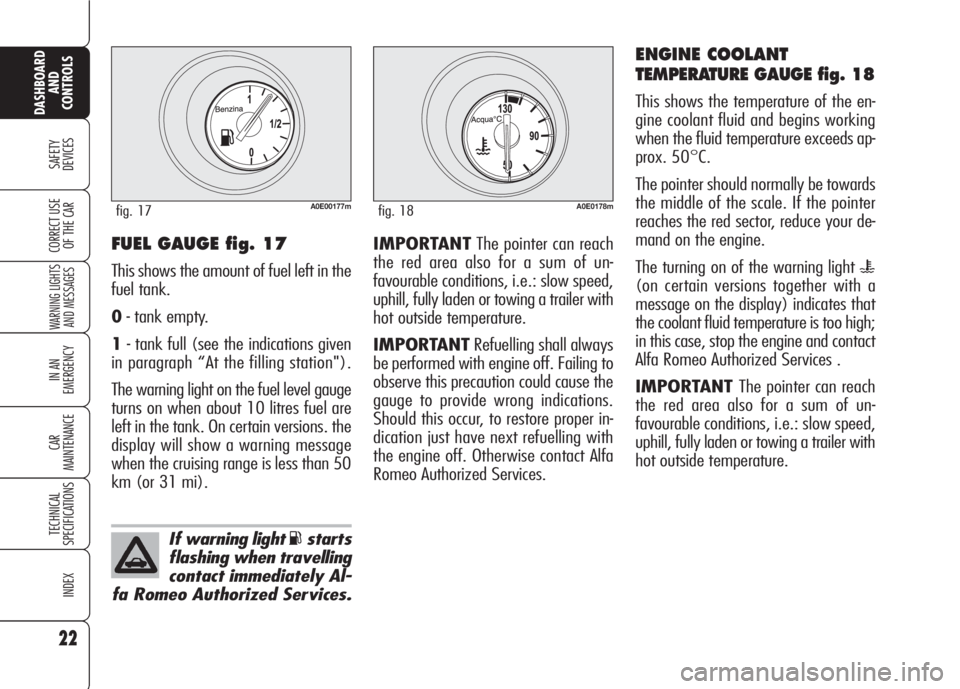
22
SAFETY
DEVICES
WARNING LIGHTS
AND MESSAGES
IN AN
EMERGENCY
CAR
MAINTENANCE
TECHNICAL
SPECIFICATIONS
INDEX
DASHBOARD
AND
CONTROLS
CORRECT USE
OF THE CARIMPORTANTThe pointer can reach
the red area also for a sum of un-
favourable conditions, i.e.: slow speed,
uphill, fully laden or towing a trailer with
hot outside temperature.
IMPORTANTRefuelling shall always
be performed with engine off. Failing to
observe this precaution could cause the
gauge to provide wrong indications.
Should this occur, to restore proper in-
dication just have next refuelling with
the engine off. Otherwise contact Alfa
Romeo Authorized Services.
ENGINE COOLANT
TEMPERATURE GAUGE fig. 18
This shows the temperature of the en-
gine coolant fluid and begins working
when the fluid temperature exceeds ap-
prox. 50°C.
The pointer should normally be towards
the middle of the scale. If the pointer
reaches the red sector, reduce your de-
mand on the engine.
The turning on of the warning light
u
(on certain versions together with a
message on the display) indicates that
the coolant fluid temperature is too high;
in this case, stop the engine and contact
Alfa Romeo Authorized Services .
IMPORTANT The pointer can reach
the red area also for a sum of un-
favourable conditions, i.e.: slow speed,
uphill, fully laden or towing a trailer with
hot outside temperature.
FUEL GAUGE fig. 17
This shows the amount of fuel left in the
fuel tank.
0- tank empty.
1- tank full (see the indications given
in paragraph “At the filling station").
The warning light on the fuel level gauge
turns on when about 10 litres fuel are
left in the tank. On certain versions. the
display will show a warning message
when the cruising range is less than 50
km (or 31 mi).
If warning light
Kstarts
flashing when travelling
contact immediately Al-
fa Romeo Authorized Services.
A0E00177mfig. 17A0E0178mfig. 18
Page 25 of 303
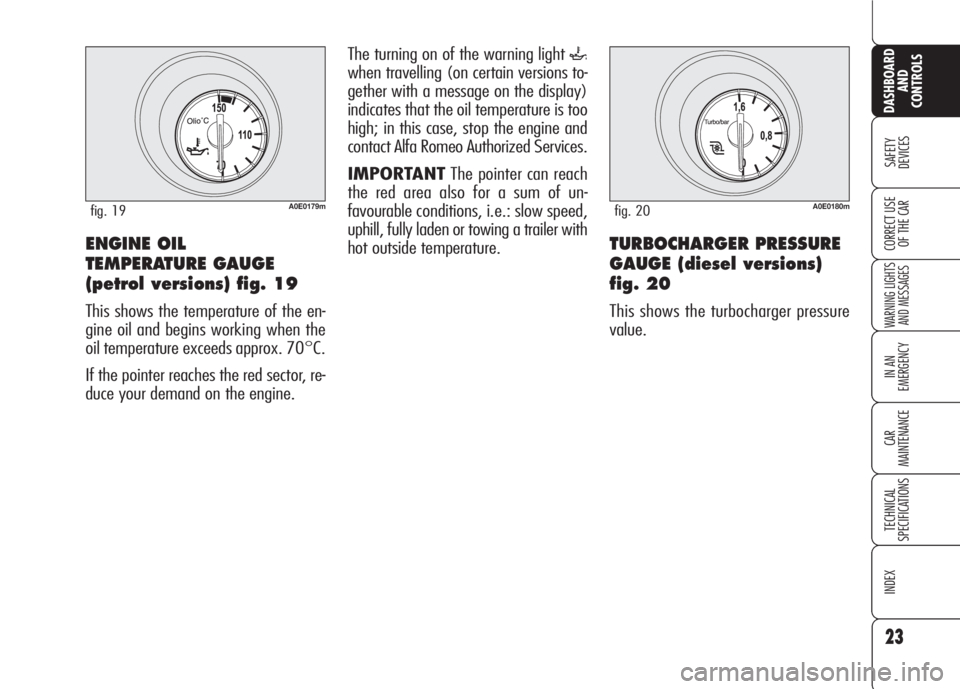
23
SAFETY
DEVICES
WARNING LIGHTS
AND MESSAGES
IN AN
EMERGENCY
CAR
MAINTENANCE
TECHNICAL
SPECIFICATIONS
INDEX
DASHBOARD
AND
CONTROLS
CORRECT USE
OF THE CAR
The turning on of the warning light `
when travelling (on certain versions to-
gether with a message on the display)
indicates that the oil temperature is too
high; in this case, stop the engine and
contact Alfa Romeo Authorized Services.
IMPORTANTThe pointer can reach
the red area also for a sum of un-
favourable conditions, i.e.: slow speed,
uphill, fully laden or towing a trailer with
hot outside temperature.
ENGINE OIL
TEMPERATURE GAUGE
(petrol versions) fig. 19
This shows the temperature of the en-
gine oil and begins working when the
oil temperature exceeds approx. 70°C.
If the pointer reaches the red sector, re-
duce your demand on the engine.
A0E0179mfig. 19A0E0180mfig. 20
TURBOCHARGER PRESSURE
GAUGE (diesel versions)
fig. 20
This shows the turbocharger pressure
value.
Page 123 of 303

121
SAFETY
DEVICES
WARNING
LIGHTS AND
MESSAGES
IN AN
EMERGENCY
CAR
MAINTENANCE
TECHNICAL
SPECIFICATIONS
INDEX
CORRECT USE
OF THE CAR
DASHBOARD
AND
CONTROLS
If a failure is indicated, stop the car, turn
the engine off and then clean the sen-
sors. Make sure to be far from possible
ultrasound sources (e.g.: truck pneu-
matic brakes or pneumatic hammers).
If failure cause has been eliminated the
system will resume regular operation
and warning
tand the corresponding
warning message will turn off.
If the warning light stays on, contact Al-
fa Romeo Authorized Services to have
the system inspected, although the sys-
tem keeps on working. If the failure de-
tected does not impair system operation,
the system keeps on working and fail-
ure is stored in order to be then detect-
ed by Alfa Romeo Authorized Services
at next inspection.
GENERAL WARNINGS
When parking, take the utmost care to
obstacles that may be set above or un-
der the sensors. Objects set close to the
car front or rear part, under certain cir-
cumstances are not detected and could
therefore cause damages to the car or
be damaged.
Indications sent by the sensors can be
altered by dirt, snow or ice deposited on
the sensors or by ultrasound systems
(e.g.: truck pneumatic brakes or pneu-
matic hammers) set nearby the car.
TOWING TRAILERS
Rear sensors are reactivated automati-
cally when removing the trailer cable
plug.
FAILURE INDICATIONS
The system control unit checks every
system component each time the key is
fitted into the ignition device. Sensors
and relevant electrical connections are
then constantly monitored during sys-
tem operation.
Sensor failure is indicated by turning on
of warning light
t(where provided)
on the instrument panel (on certain ver-
sions together with the message on the
display) (see section “Warning lights
and messages”).
Rear sensors operation
is deactivated automat-
ically when the trailer
electric cable plug is fitted into
the car tow hook socket.
Page 153 of 303

151
SAFETY
DEVICES
WARNING
LIGHTS AND
MESSAGES
IN AN
EMERGENCY
CAR
MAINTENANCE
TECHNICAL
SPECIFICATIONS
INDEX
DASHBOARD
AND
CONTROLS
CORRECT USE
OF THE CAR
C C
O O
R R
R R
E E
C C
T T
U U
S S
E E
O O
F F
T T
H H
E E
C C
A A
R R
ENGINE STARTING .............................................. 152
PARKING ........................................................... 155
USING THE GEARBOX ......................................... 156
CONTAINING RUNNING COSTS ............................. 157
TOWING TRAILERS.............................................. 159
SNOW TYRES .................................................... 162
SNOW CHAINS .................................................. 163
CAR INACTIVITY ................................................ 164
Page 159 of 303
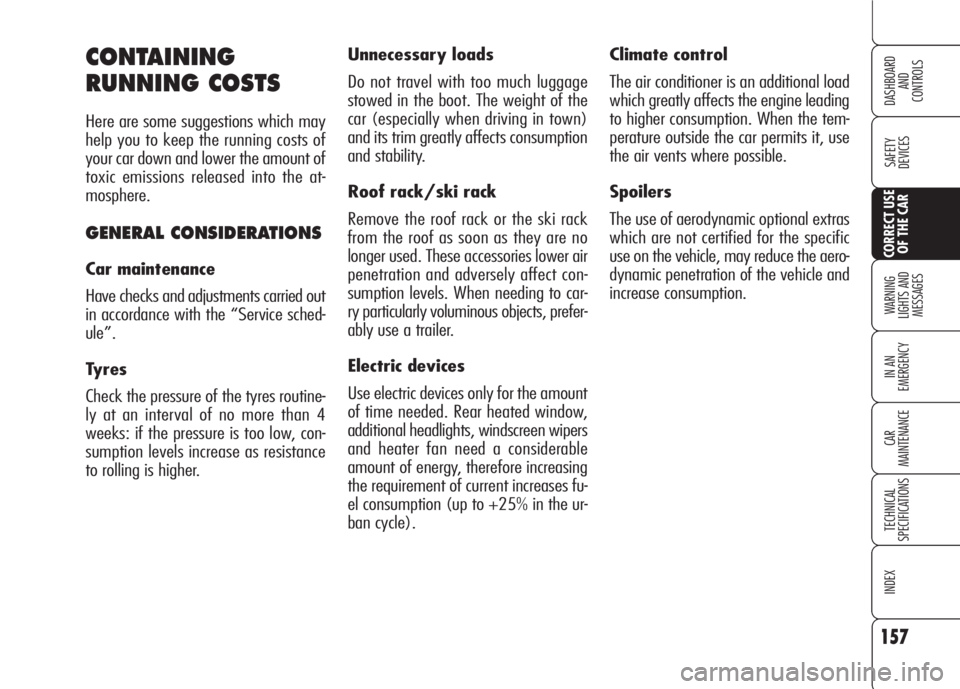
157
SAFETY
DEVICES
WARNING
LIGHTS AND
MESSAGES
IN AN
EMERGENCY
CAR
MAINTENANCE
TECHNICAL
SPECIFICATIONS
INDEX
DASHBOARD
AND
CONTROLS
CORRECT USE
OF THE CAR
Climate control
The air conditioner is an additional load
which greatly affects the engine leading
to higher consumption. When the tem-
perature outside the car permits it, use
the air vents where possible.
Spoilers
The use of aerodynamic optional extras
which are not certified for the specific
use on the vehicle, may reduce the aero-
dynamic penetration of the vehicle and
increase consumption. Unnecessary loads
Do not travel with too much luggage
stowed in the boot. The weight of the
car (especially when driving in town)
and its trim greatly affects consumption
and stability.
Roof rack/ski rack
Remove the roof rack or the ski rack
from the roof as soon as they are no
longer used. These accessories lower air
penetration and adversely affect con-
sumption levels. When needing to car-
ry particularly voluminous objects, prefer-
ably use a trailer.
Electric devices
Use electric devices only for the amount
of time needed. Rear heated window,
additional headlights, windscreen wipers
and heater fan need a considerable
amount of energy, therefore increasing
the requirement of current increases fu-
el consumption (up to +25% in the ur-
ban cycle).CONTAINING
RUNNING COSTS
Here are some suggestions which may
help you to keep the running costs of
your car down and lower the amount of
toxic emissions released into the at-
mosphere.
GENERAL CONSIDERATIONS
Car maintenance
Have checks and adjustments carried out
in accordance with the “Service sched-
ule”.
Tyres
Check the pressure of the tyres routine-
ly at an interval of no more than 4
weeks: if the pressure is too low, con-
sumption levels increase as resistance
to rolling is higher.
Page 161 of 303
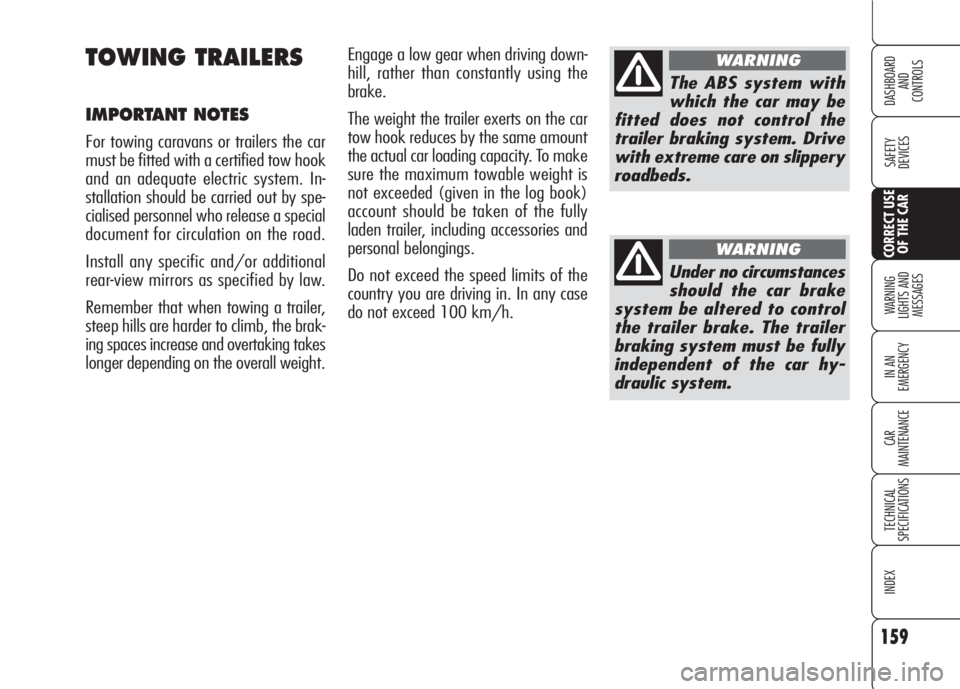
159
SAFETY
DEVICES
WARNING
LIGHTS AND
MESSAGES
IN AN
EMERGENCY
CAR
MAINTENANCE
TECHNICAL
SPECIFICATIONS
INDEX
DASHBOARD
AND
CONTROLS
CORRECT USE
OF THE CAR
Engage a low gear when driving down-
hill, rather than constantly using the
brake.
The weight the trailer exerts on the car
tow hook reduces by the same amount
the actual car loading capacity. To make
sure the maximum towable weight is
not exceeded (given in the log book)
account should be taken of the fully
laden trailer, including accessories and
personal belongings.
Do not exceed the speed limits of the
country you are driving in. In any case
do not exceed 100 km/h.TOWING TRAILERS
IMPORTANT NOTES
For towing caravans or trailers the car
must be fitted with a certified tow hook
and an adequate electric system. In-
stallation should be carried out by spe-
cialised personnel who release a special
document for circulation on the road.
Install any specific and/or additional
rear-view mirrors as specified by law.
Remember that when towing a trailer,
steep hills are harder to climb, the brak-
ing spaces increase and overtaking takes
longer depending on the overall weight.
The ABS system with
which the car may be
fitted does not control the
trailer braking system. Drive
with extreme care on slippery
roadbeds.
WARNING
Under no circumstances
should the car brake
system be altered to control
the trailer brake. The trailer
braking system must be fully
independent of the car hy-
draulic system.
WARNING
Page 185 of 303

183
SAFETY
DEVICES
WARNING
LIGHTS AND
MESSAGES
CAR
MAINTENANCE
TECHNICAL
SPECIFICATIONS
INDEX
CORRECT USE
OF THE CAR
DASHBOARD
AND
CONTROLS
IN AN
EMERGENCY
IF A TYRE
IS PUNCTURED
For versions/markets where applicable,
the car can be equipped with the “Quick
tyre repair kit Fix&Go automatic“. Op-
erations required to change a wheel are
described in the following chapter.
As an alternative to the kit “Fix & Go
automatic”, the car can be provided (up-
on request) with space-saver spare
wheel or standard size spare wheel;
wheel changing and correct use of the
jack and space-saver spare wheel call for
some precautions as listed below.
BUMP STARTING
Never bump start the engine (by push-
ing, towing, or coasting downhill) as this
could cause fuel to flow into the catalytic
exhaust system and damage it beyond
repair.
Remember that the
brake booster and the
power steering system are not
operating until the engine is
started, a greater effort will
therefore be required to press
the brake pedal or turn the
steering wheel.
WARNING
Alert other drivers that
the car is stationary in
compliance with local regula-
tions: hazard warning lights,
warning triangle etc. Any pas-
sengers on board should leave
the car, especially if it is heav-
ily laden. Passengers should
stay away from oncoming
traffic while the wheel is be-
ing changed on. If the wheel is
being changed on a steep or
badly surfaced road, place the
wedges or other suitable ma-
terial under the wheel to stop
the car. Never start the engine
when the car is jacked up. If
you were towing a trailer, un-
couple the trailer before jack-
ing the car.
WARNING
Page 229 of 303

227
SAFETY
DEVICES
WARNING
LIGHTS AND
MESSAGES
IN AN
EMERGENCY
TECHNICAL
SPECIFICATIONS
INDEX
CORRECT USE
OF THE CAR
DASHBOARD
AND
CONTROLS
CAR
MAINTENANCE
USE OF THE CAR
UNDER HEAVY
CONDITIONS
Should prevailing use of the car be un-
der one of the following specially heavy
conditions:
❒ trailer or caravan towing;
❒ dusty roads;
❒ short distances (less than 7-8 km)
and repeated with external temper-
atures below zero;
❒ frequently idling engines or long dis-
tance low speed driving (e.g.: door-
to-door deliveries) or in case of a long
term inactivity;
❒ urban routes;
carry out checks more frequently than
required on Service Schedule:
❒ check front disk brake pad conditions
and wear;
❒ check cleanness of bonnet and boot
locks and lever cleanness and lubri-
cation;
❒ sight inspect the conditions of: en-
gine, gearbox, transmission, pipes
and hoses (exhaust - fuel - brakes),
rubber parts (boots, sleeves, bushes,
etc.);
❒ check battery charge and fluid level
(electrolyte);
❒ visual check on various drive belt con-
ditions;
❒ change engine oil and oil filter, if re-
quired;
❒ check and replace pollen filter, if re-
quired;
❒ check and replace air cleaner, if re-
quired.
PERIODICAL CHECKS
Every 1,000 km or before long jour-
neys, check and top up if required:
❒engine coolant fluid level;
❒brake fluid level;
❒windscreen washer fluid level;
❒ tyre pressure and conditions.
❒ check light system operation (head-
lights, direction indicators, hazard
lights, etc.);
❒ check windscreen wiper/washer op-
eration and windscreen/rear window
blade position/wear;
Every 3,000 km check and top up if re-
quired: engine oil level.
You are recommended to use FL Se-
leniaproducts, designed and produced
specifically for Alfa Romeo cars (see
table “Capacities” in section “Techni-
cal specifications”).
Page 296 of 303
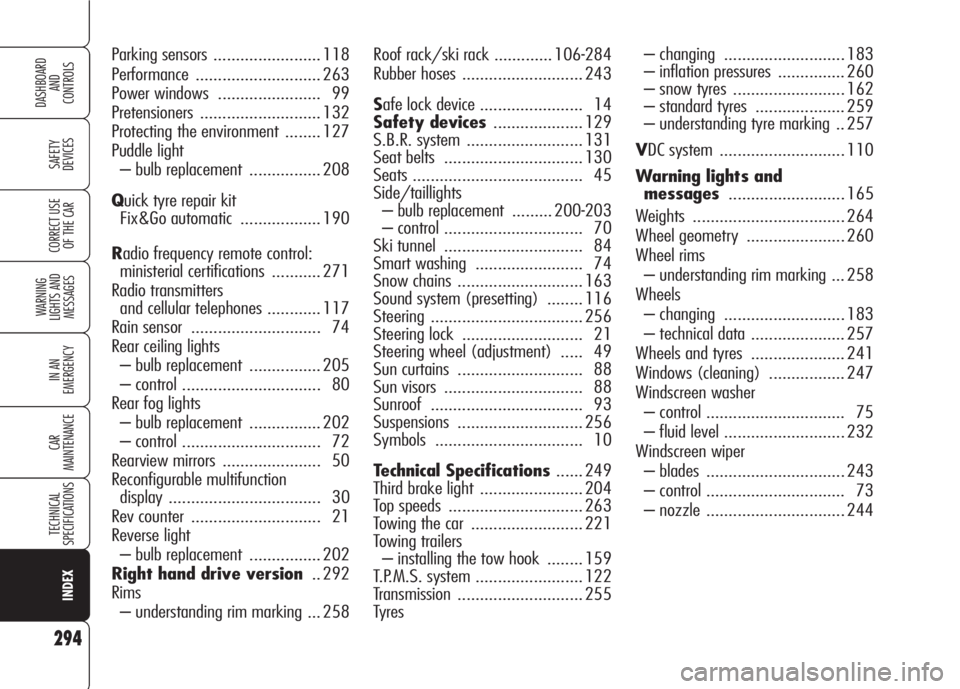
294
SAFETY
DEVICES
WARNING
LIGHTS AND
MESSAGES
IN AN
EMERGENCY
CAR
MAINTENANCE
TECHNICAL
SPECIFICATIONS
CORRECT USE
OF THE CAR
DASHBOARD
AND
CONTROLS
INDEX
Roof rack/ski rack ............. 106-284
Rubber hoses ........................... 243
Safe lock device ....................... 14
Safety devices.................... 129
S.B.R. system .......................... 131
Seat belts ............................... 130
Seats ...................................... 45
Side/taillights
– bulb replacement ......... 200-203
– control ............................... 70
Ski tunnel ............................... 84
Smart washing ........................ 74
Snow chains ............................ 163
Sound system (presetting) ........ 116
Steering .................................. 256
Steering lock ........................... 21
Steering wheel (adjustment) ..... 49
Sun curtains ............................ 88
Sun visors ............................... 88
Sunroof .................................. 93
Suspensions ............................ 256
Symbols ................................. 10
Technical Specifications...... 249
Third brake light ....................... 204
Top speeds .............................. 263
Towing the car ......................... 221
Towing trailers
– installing the tow hook ........ 159
T.P.M.S. system ........................ 122
Transmission ............................ 255
Tyres– changing ........................... 183
– inflation pressures ............... 260
– snow tyres ......................... 162
– standard tyres .................... 259
– understanding tyre marking .. 257
VDC system ............................ 110
Warning lights and
messages.......................... 165
Weights .................................. 264
Wheel geometry ...................... 260
Wheel rims
– understanding rim marking ... 258
Wheels
– changing ........................... 183
– technical data ..................... 257
Wheels and tyres ..................... 241
Windows (cleaning) ................. 247
Windscreen washer
– control ............................... 75
– fluid level ........................... 232
Windscreen wiper
– blades ............................... 243
– control ............................... 73
– nozzle ............................... 244 Parking sensors ........................ 118
Performance ............................ 263
Power windows ....................... 99
Pretensioners ........................... 132
Protecting the environment ........ 127
Puddle light
– bulb replacement ................ 208
Quick tyre repair kit
Fix&Go automatic .................. 190
Radio frequency remote control:
ministerial certifications ........... 271
Radio transmitters
and cellular telephones ............ 117
Rain sensor ............................. 74
Rear ceiling lights
– bulb replacement ................ 205
– control ............................... 80
Rear fog lights
– bulb replacement ................ 202
– control ............................... 72
Rearview mirrors ...................... 50
Reconfigurable multifunction
display .................................. 30
Rev counter ............................. 21
Reverse light
– bulb replacement ................ 202
Right hand drive version.. 292
Rims
– understanding rim marking ... 258